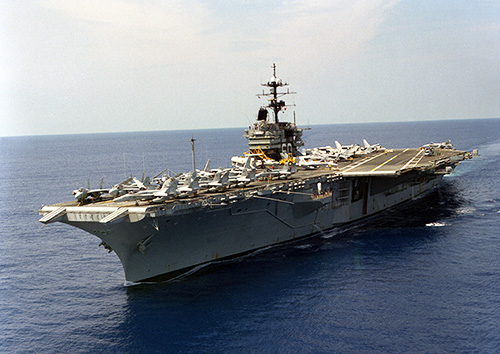
1941-1959 Deck Logs, including World War 2 and the Korean War
Logs dating from the 1941-1959 period typically include a monthly title sheet, daily remarks sheets, and daily columnar sheets. Through spring 1956, most logs also contain monthly officer lists. The list of officers typically provides the name, rank, date of reporting on board, primary duties, and name and address of next of kin for each officer assigned to the vessel. Officer lists were sometimes omitted, when this happens it typically occurs in the case of small vessels. Beginning in the spring of 1956, officer data is captured in the ship's muster rolls and conforms to the standards of those documents.
Deck log remarks sheets contain chronological accounts of events or other data that was considered important, including when changes in course and speed occurred; important landmarks were sighted; boilers were engaged or shut down; exercises were conducted; provisions or fuel were received. The typical log from 1941-1959 also indicates when personnel were transferred, received, or returned from leave, and may also briefly describe operational activities and list crewmen wounded or killed in action. They also contain information on disciplinary actions that occurred on board the ship, such as deck courts and courts martial. This includes the name(s) of the accused, the charges, verdict and sentence, but not the details of the proceedings. Logs from this period also usually contain an entry when a report of an injury to a crewman was received, with a brief description of the injury, the initial treatment, and whether or not the crewman was immediately returned to duty.
Entries on the remarks sheet generally appear in four-hour blocks that correspond to the major "watches" 2000 - 2400, called the first watch, 0000 - 0004; the middle watch, 0400 - 0800, the morning watch; 0800 - 1200, the forenoon watch; 1200 - 1600, the afternoon watch; 1600 - 2000, the dog watch. Each block of entries was signed by the officer of the deck, usually a junior officer (often an ensign or lieutenant [junior grade]), and approved by the navigation officer.
Columnar sheets contain spaces for filling in the name and/or hull number of the vessel, the date, and detailed meteorological, hydrographic, and navigational data. This data includes wind speed and direction, barometric pressure, air and water temperature, cloud type and altitude, visibility and overall weather conditions, as well as latitude and longitude, amount of fuel and water expended and remaining on hand, the hull's draft, and temperature in the ship's magazines. Sometimes columnar sheets were not always filled in, or were only partially completed.
Some smaller vessels, usually unnamed, submitted small-format "patrol logs" during World War 2, and these small volumes typically include a title page, a list of officers and enlisted personnel, and remarks pages that feature spaces for filling in weather information at the top of each page. This data includes wind direction and speed, barometric pressure, air temperature, state of weather and clouds, and general sea conditions. The personnel lists typically contain notations indicating when each officer or enlisted man reported aboard the vessel, and, if it occurred during the period covered by that particular log, when they transferred.

